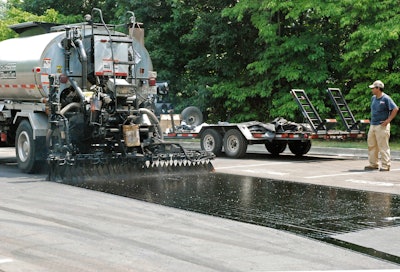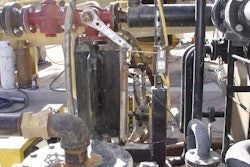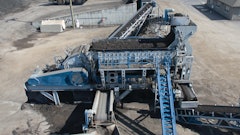
In my career I have operated, maintained, torn down, moved and re-set many asphalt plants. A guess would be in excess of two hundred plants, possibly closer to three hundred plants. The vast majority of these plants had tack available to their company distributor trucks and for sale in bulk to customers. So after 40 + years I am supremely experienced in the process.
The process usually involves using a special rubber hose to pump the tack into the distributor, either through a dedicated fitting on the tank or that hose is simply put into the lid on the top of the tank. Once the tack transfer is completed, the industry standard and my professionally preferred method of ‘clean-out is to run diesel into any off-loading hose after use, then that hose is suspended at one end with the pump running reversed, in suction mode. This method assures that the hose is always clean and free from obstructions. For subsequent reuse, I only recommend “slight” heating of metal fittings and valves to facilitate correct operation.
When that off-loading hose is improperly handled, the residual oil can congeal in the hose even when it has had diesel put through it. To clear blockages, some people’s first inclination is to heat that hose with a weed burner. What few laymen seem to know is that the “flash point” diesel is approximately 165° F which is easily exceeded when the 1,800° F flame from a weed burner is liberally applied to the hose.
In recent years, I have moved into being an expert witness in a number of asphalt plant accident cases. In a number of these cases the injuries resulted from exploding diesel that had collected in off-loading hoses. Among the victims and the crew a common thought was, ‘I didn’t think diesel could burn.’ Say WHAT?
The last time I heard this statement was from a guy who got burned over 60% of his body while loading tack into a distributor trailer. His buddy was on the ground heating the loading hose with a weed burner, while this guy stared down into the top of the tank watching for flow. He heard a boiling sound, then flames erupted from the lid of the tank and engulfed him in fire. His working career was over at this point. And he now had over a year of recovery and a dozen surgeries to look forward too.
I feel what happened in this case was that there was a ‘clog’ of tack in the rubber line, possibly mixed with diesel. As the weed burner heated the line up the diesel in the hose quickly passed the 165° F critical point. Now all it needed was oxygen. However, even if diesel was not present in the line, as it was heated the base asphalt that tack is made from separated from the water ‘cut-back’ and the temperature of the base asphalt rose to a critical point. Crews seem to think that tack is innocuous also, but we need to understand that it can also be made flammable.
The data below is copied directly from the Product Data Sheet (Copy Included) issued in Texas by Martin Asphalt describing the uses and protocols for storing SS-1h. Note the Temperature Chart at the bottom.
The water-based emulsion should not be exposed to overheating. The anionic emulsion is a chemically stabilized system, so care should be taken not to upset the chemical balance with contamination by chemicals, over-exposure to air, or adverse mechanical or thermal conditions. Before being filled, tanks and trucks should be examined for possible contaminants. Recommended use and storage temperatures are given in the table.
Recommended Temperatures: Min Max
Storage 50ºF 140ºF
Application 50ºF 130ºF
In my opinion by heating any transfer hose with an 1,800° F flame from a weed burner/torch the temperature of the residual tack in the hose could quickly exceed the 140° F maximum recommended temperature and chemical destabilization would cause the base asphalt to separate from the water and other emulsifying agents (soap for instance) blended into the asphalt to produce tack. This would cause a low pressure build up of heated fumes in the hose which then could force its way into the tank as the blockage cleared. This ‘pressure’ would subsequently force the diesel fumes in the tank to waft out of the lid and supply it with the oxygen it needs to combust.
In this case, when the crewman ran the flame from the weed burner up the hose in an effort to heat it and clear the internal blockage he inadvertently cause the material in that hose to heat up past the 165° F flash point and as the obstruction cleared the super-heated liquids combined with free oxygen in the tank and exploded.
While reading depositions relating to a number of such explosion/fire cases, it is very clear to me that most workmen received almost NO training in the handling of flammable materials. In fact, one victim in a case I was involved in stated that diesel is ‘not flammable’. In this case, both men clearly indicate that almost NO safety training was offered to them, just directions on how to clean out the equipment. I believe that this lack of training led directly to accident. It was clear from everyone’s depositions that there was no fear of fire. Therefore, no reason to take any elevated precautions when someone put 1,800° F of heat on a ¼-in. thick piece of rubber to unclog a hose containing Volatile petroleum products.
In this particular case the injured party was wearing almost NONE of the OSHA recommended safety equipment. Had he been properly attired, his injuries would quite possibly have been very limited. Surely they would not have been career ending.
OSHA regulations required that the man’s employer provide him with suitable Personal Protective Equipment (PPE) as needed for the performance of his job. In my opinion, at minimum this would include a “flame-proof” long sleeve shirt, gauntlet style leather gloves and a hard hat with face shield. Some places also include a leather apron down the front. These are the industry standards that I teach at all our safety seminars.
Summary of my Professional Expert Opinion: There is direct linkage between the improper heating of the Asphalt/Tack off-loading hose and the subsequent “flash” of fire. Therefore it is my professional opinion that the fire would not have happened without the application of the heat from the weed-burner flame to the off-loading hose and the employees’ injuries would have been far less severe had he been using even the most basic of OSHA Safety Equipment recommended for handling hot oils and emulsions.



















